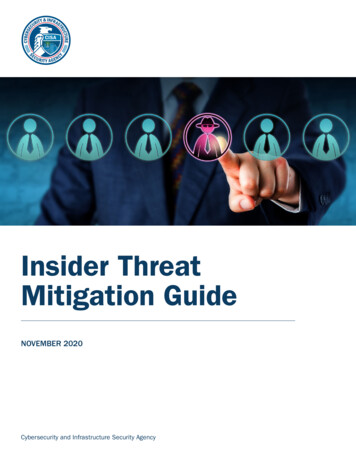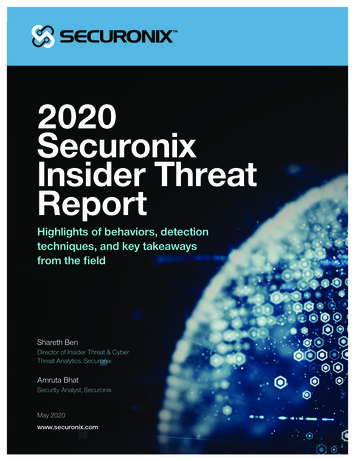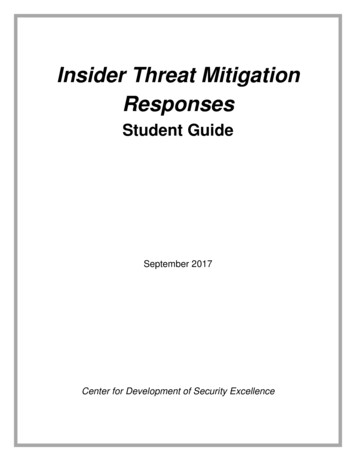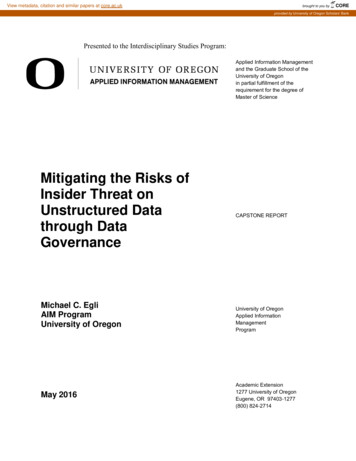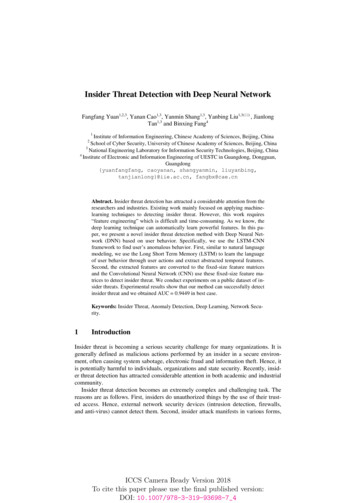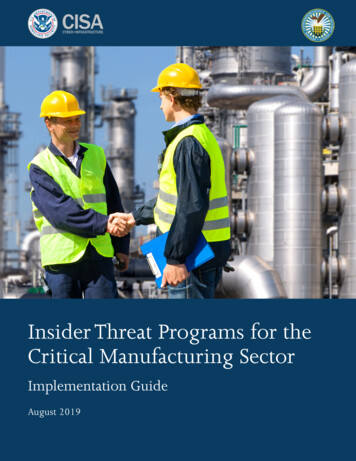
Transcription
CYBER INFRASTRUCTUREInsider Threat Programs for theCritical Manufacturing SectorImplementation GuideAugust 2019
This page intentionally left blank.2Insider Threat Programs for the Critical Manufacturing Sector Implementation Guide
Letter from the Assistant Director andthe DirectorThreats from trusted insiders with authorized access to an organization can wittingly or unwittingly harmthat organization, its resources, and disrupt operations. Unmitigated insider risk can increase the dangerof attack on an organization.The Department of Homeland Security’s Cybersecurity and Infrastructure Security Agency (CISA)works closely with the Critical Manufacturing Sector to improve the sector’s security and resilience. TheDepartment of Defense’s Defense Counterintelligence and Security Agency supports cleared facilities’efforts to protect classified information. Both agencies’ missions involve creating resources to helporganizations protect against insider threats.The Insider Threat Programs for the Critical Manufacturing Sector Implementation Guide was developedto provide guidance and information for critical manufacturing organizations to establish insider threatprograms. These programs serve to gather, monitor, and assess information for insider threat detectionand mitigation strategies. Insider threat programs are designed to detect, deter, and mitigate the risksassociated with trusted insiders and protect the privacy of the workforce while reducing potential harmto the organization. Effective insider threat programs deploy risk management strategies that identify theassets or resources to be protected, identify potential threats, determine vulnerabilities, assess risk, anddeploy countermeasures.CISA and DCSA appreciate the participation and dedication in developing this guide of GovernmentCoordinating Council (GCC) and Sector Coordinating Council (SCC) members along with members of ourprivate sector. A more protected Critical Manufacturing Sector from insider threats is a stronger sector.As CISA's Assistant Director for Infrastructure Security and DCSA’s Director of the Center forDevelopment of Security Excellence, we encourage you to use and reference this Guide. Thank you foryour partnership and commitment to securing our nation.Sincerely,Brian HarrellAssistant Director for Infrastructure SecurityKevin JonesDirector of the Center for Development of Security ExcellenceInsider Threat Programs for the Critical Manufacturing Sector Implementation Guideiii
This page intentionally left blank.ivInsider Threat Programs for the Critical Manufacturing Sector Implementation Guide
Trusted insiders, both witting and unwitting, can causegrave harm to your organizations, facilities, resources,and personnel. Insider incidents account for billions of dollarsannually in “actual” and “potential” lost revenue related totrade secret theft, fraud, sabotage, damage to an organization’sreputation, acts of workplace violence, and more. Insider threatprograms can mitigate risks associated with trusted insiders.Click the links to learn how to establish an insider threat programat your organization and develop a risk management strategythat addresses areas critical to manufacturing.Understandingthe InsiderThreatEstablishing anInsider ThreatProgramInsider RiskManagementStrategyInsider ThreatProgramResourcesPage 3Page 5Page 9Page 13Insider Threat Programs for the Critical Manufacturing Sector Implementation Guide1
2INSIDER THREAT PROGRAMS for the Critical Manufacturing Sector IMPLEMENTATION GUIDE
1 Understanding the Insider ThreatWhat is an Insider Threat?Anyone with authorized access who uses thataccess to wittingly or unwittingly harm theorganization and its resources. Insiders can includeemployees, vendors, partners, suppliers, and othersto whom you provide access to your facilities and/or information. Most insider threats exhibit riskybehavior prior to committing negative workplaceevents. If identified early, many risks can bemitigated before harm to the organization occurs.Learn more about insider threat indicators and findfree training and awareness materials at at Risks Do Insider Threats Poseto Critical Manufacturing?Numerous threats have the potential to causemajor disruption in manufacturing operations.These include malicious acts committed by insiderssuch as fraud, theft, sabotage, workplace violence,and more. Unwitting insiders may inadvertentlydisclose proprietary or other sensitive information,unknowingly download malware, or facilitate othercybersecurity events. The critical manufacturingsector reports the highest number of attackson industrial control systems of any criticalinfrastructure sector. Unmitigated insider risk is likelyto increase the risk of attack. See the case study atright or visit https://www.cdse.edu/resources/casestudies.html for more real-world events.What Can My Organization Do toReduce the Risk Associated withTrusted Insiders?Effective insider threat programs deploy riskmanagement strategies that identify the assets orresources to be protected, identify potential threats,determine vulnerabilities, assess risk, and deploycountermeasures. Many countermeasures are noor low cost to the organization and include trainingand awareness, clear reporting policies, managingorganizational trust, and enhanced securityprocedures. Review the Insider Risk ManagementStrategy on page 9 to learn more.What Resources are Available to Me?The Department of Homeland Security, Departmentof Defense, National Insider Threat Task Force,Federal Bureau of Investigation, and NationalCounterintelligence and Security Center havenumerous free resources available to yourorganization. Review the Resources section on page13 to learn more.Wen Chyu LiuWhy Establish an Insider ThreatProgram?Insider threat programs are designed to detect,deter, and mitigate the risks associated with trustedinsiders. Multidisciplinary teams comprised ofsecurity, human resources, cyber/informationtechnology (IT), legal, and other professionals fromthroughout your organization gather, integrate,and assess information indicative of potential riskand determine appropriate mitigation responseoptions on a case-by-case basis. Insider threatprograms protect the privacy of the workforce whilereducing potential harm to the organization. See theEstablishing an Insider Threat Program section onpage 5 to learn more.Insider Threat Programs for the Critical Manufacturing Sector Implementation GuideWhile employed at a major manufacturing company,Liu worked as a research scientist on variouselastomer products. Liu conspired with at least fourcurrent and former employees to steal elastomertrade secrets and sell them in China. The companylost valuable research that impacted numerousprojects. Long-held trade secrets were disclosed tocompetitors and the public and profits from currentand future projects were compromised. Numerousemployees were fired and several prosecuted.Read the full case study at df.3
4Insider Threat Programs for the Critical Manufacturing Sector Implementation Guide
2 Establishing an Insider ThreatProgramSetting Up Your ProgramAn insider threat program is a multidisciplinaryactivity established by an organization to gather,monitor, and assess information for insider threatdetection and mitigation. Program personnelanalyze information and activity indicative of aninsider risk and determine appropriate mitigationresponse options up to and including referral tothe appropriate officials for investigation and/orresolution. Best practices encourage the insiderthreat program to include a multidisciplinaryteam consisting of Legal Counsel, Security,Counterintelligence, Cybersecurity, MentalHealth and Behavioral Science, and HumanResources or Human Capital disciplines toeffectively counter insider threats to yourorganization. The exact makeup of your insiderthreat program will depend on the size andcomplexity of your organization.Insider threat programs take proactive measuresto deter, detect, mitigate, and report thethreats associated with trusted insiders. Theprogram identifies anomalous behaviors thatmay indicate an individual poses a risk. Earlyidentification allows insider threat programpersonnel to focus on an individual’s issues ofconcern or stressors and deploy appropriatemitigation responses. When necessary, the teamshares relevant information from each disciplinewith organizational leadership to facilitatetimely, informed decision-making and reportsinformation outside the organization as required.The first step in establishing your program is toidentify the program office and leadership.You must determine how the team will bestructured and where it will be located. Does yourorganization have the ability to house the teamin a single location? Or are the team membersgeographically separated and must rely on virtualcommunications to conduct operations? Yourorganization should select an insider threatInsider Threat Programs for the Critical Manufacturing Sector Implementation Guideprogram senior leader or program managerwho oversees day-to-day operations. They willwork with the organization’s senior leadership todetermine resource and staffing needs.You should establish rules for how theinsider threat program will operate withinyour organization. As part of rule and policydevelopment, the insider threat program shouldalso identify practices for safeguarding sensitivepersonnel information along with consequencesfor violations of internal rules committed by insiderthreat program team members. Insider threat teammembers must maintain standards of professionalconduct like any other personnel. However,because you’re dealing with extremely sensitiveinformation it’s important that you clarify theseresponsibilities up front. A sample insider threatprogram plan is included in the Resources section.You should also ensure that insider threatprogram personnel are properly trained toconduct their duties. Insider threat programpersonnel must be able to appropriately respondto incident reporting, protect privacy and civilliberties, support mitigation options, and refermatters as required. Many free training optionsexist. Consult the Resources section on page 13for more information.Detecting and Deterring InsiderThreatsThe purpose of an insider threat program is toproactively deter, detect, mitigate, and reportthreats associated with trusted insiders. Theseactions make up your daily operations. Insiderthreat programs detect individuals at risk ofbecoming insider threats by identifying potentialrisk indicators. These observable and reportablebehaviors or activities may indicate an individual isat greater risk of becoming a threat. Insider threathubs deter potential insider threats by institutingappropriate security countermeasures, includingawareness programs.5
Training and Awareness Programs. You musttrain and exercise your workforce to recognizeand report potential risk indicators. It is a bestpractice to require personnel to complete initialand annual insider threat awareness training. Youcan also maintain workforce awareness of insiderthreats and employee reporting responsibilitiesyear-round by instituting a vigilance campaign.Insider threat programs can also conduct internalevaluations. These are small exercises used totest your workforce’s knowledge of insider threatindicators and reporting requirements. Theseexercises do not have to be elaborate but shouldhelp you gauge the effectiveness of your program.You may use information from these evaluationsto adjust your training and awareness programto ensure effectiveness. See the Resourcessection on page 13 for access to free training andawareness materials.Reporting Procedures. Your insider threatprogram must establish reporting proceduresfor the general workforce. Those who witnesspotential indicators should know exactly when,where, and how they can report the information.Prepare procedures for "walk-ins" or those whomay want to report their information face toface. Procedures should also include hotlines ordedicated email addresses. Individuals should beencouraged to self-report any issues they may beexperiencing. One of the goals of an insider threatprogram is to deter adverse actions by pointingthose asking for assistance to resources thatcan help them. The challenge is to have peoplesee the insider threat program as a resourcerather than a punitive element. You can buildthis rapport by informing the workforce of yourprogram, the mission, and its goals; by respectingprivacy and civil liberties; and by deployingappropriate insider threat mitigation responses.Organizational Justice. As a best practice, insiderthreat programs should consider the conceptof organizational justice. Organizational justicerefers to employee perceptions of fairness inthe workplace. Labor relations can have anoverall effect on the number of insider threatincidents you see. The worse the labor relationsare, the more incidents you may encounter.Counterproductive workplace environments have6consequences that can lead to disgruntlement.Organizational leadership that develops a positiveworkplace environment keeps the workforceengaged and productive. This same conceptapplies to the insider threat program. Ensuringappropriate mitigation response options andthe protection of privacy and civil liberties in theconduct of your duties will minimize negativeoutcomes from maladaptive responses. Beingresponsive to workforce concerns is a great wayto build rapport with personnel; encourage futurereporting; and ultimately mitigate risk.Instituting User ActivityMonitoringUser Activity Monitoring (UAM) is the technicalcapability to observe and record the actionsand activities of an individual operating onyour computer networks to detect potential riskindicators and to support mitigation responses.Logging, monitoring, and auditing of informationsystem activities can lead to early discovery andmitigation of behavior indicative of insider threat.UAM also plays a key role in prevention, assistance,and response to acts of violence. As such, UAMdevelopment should include consideration ofpotential acts of violence against organizationalresources, including suicidal ideation.Implementation will be specific to your location,but as a best practice your organizations should: Define what will be monitored Indicate how monitoring will be instituted Inform users of monitoring actions viabanners Identify indicators that require review(e.g., trigger words, activities) Protect user activity monitoring methodsand results Develop a process for verification and reviewof potential issues Establish referral and reporting proceduresEstablishing baseline user behaviors will makedeviations or anomalies stand out from normalactivities. It will also help determine what your useractivity monitoring triggers, also known as internalsecurity controls, should be. Once a “NormalInsider Threat Programs for the Critical Manufacturing Sector Implementation Guide
Activity” baseline is established, internal securitycontrols help us identify deviations. For example,user activity monitoring could help identify a rash ofIT system misuses that suggest an employee needssome re-training. Another example would be accesscontrol logs indicating an employee is workingirregular hours or has unexplained absences fromwork. UAM can help identify potential risk indicatorsthat can be evaluated during your risk managementand mitigation process.Insider Threat Programs for the Critical Manufacturing Sector Implementation GuideFor more information, access the Insider ThreatIndicators in User Activity Monitoring job aid t-Indicators-in-UAM.pdf.Now that you’ve established an insider threatprogram, it’s time to employ risk management andmitigation strategies. Your insider threat programshould be able to identify and mitigate many issuesbefore they escalate into negative behavior andrespond appropriately when preventative actions arenot feasible. Access the Insider Risk ManagementStrategy section on page 9 to learn more.7
8Insider Threat Programs for the Critical Manufacturing Sector Implementation Guide
3 Insider Risk Management StrategyRisk AnalysisRisk-based analysis allows the insider threatprogram to manage risk in a complex threatenvironment. The process of identifyingassets, assessing threats and vulnerabilities,evaluating risk, and identifying countermeasurescan help determine the risks most closelyassociated with trusted insiders in the criticalmanufacturing sector and the best methodsto deter and mitigate them. It also allows yourorganization to differentiate between exigent threatsto your enterprise and less pressing matters.Identify Critical AssetsThe most basic function of an insider threatprogram is to protect the assets that provideyour organization with a competitive advantage.According to ISO 55000, an asset is somethingwith potential value to an organization and forwhich the organization has a responsibility (Riso2012). We further elaborate on this definitionby stating that a critical asset can be thoughtof as something of value that, if destroyed,altered, or otherwise degraded, would impactthe confidentiality, integrity, or availability andhave a severe negative effect on the ability of theorganization to support essential missions andbusiness functions.Critical assets can be both physical and logicaland can include facilities, systems, equipment,and technology. An often overlooked aspect ofcritical assets is intellectual property. This mayinclude proprietary software, customer data forvendors, schematics, and internal manufacturingprocesses. The organization must keep a closewatch on where data is at rest and in transport.Current technology allows more seamlesscollaboration than ever, but also allows theorganization’s sensitive information to be easilyremoved from the organization.A complete understanding of critical assets(both physical and logical) is invaluable indefending against attackers who will often targetInsider Threat Programs for the Critical Manufacturing Sector Implementation Guidethe organization’s critical assets. The followingquestions help the organization to identify andprioritize the protection of its critical assets: What critical assets do we have? Do we know the current state of each criticalasset? Do we understand the importance of eachcritical asset and explain why it is critical toour organization? Can we prioritize our list of critical assets? Do we have the authority, money, andresources to effectively monitor our criticalassets?The role of the program manager is to work withall of those across all areas of the organizationto answer the questions above. Once thosequestions are answered within each division,input from senior-level management shouldbe obtained to prioritize protection across theorganization. Once critical assets are identifiedand prioritized, the organization must identifythose high-risk users who most often interactwith the critical systems or data. This will helpthe organization to identify the best approaches tosuccessfully identify potential insider threats.Conducting a Risk AssessmentThe Risk Management ProcessRisk management is an eight step process thatprovides a framework for collecting and evaluatinginformation to: Identify assets (identify value of asset) Assess threats (intent and capability ofadversaries) Assess vulnerabilities (identification andextent of vulnerabilities) Assess risk (determine the likelihood that athreat will exploit your vulnerabilities) Determine impact of loss, damage, orcompromise of asset9
Develop countermeasures (securitycountermeasure options that can reduce ormitigate risks cost effectively) Apply countermeasures Monitor and re-evaluateFor more information on risk management, html.You may also consider implementing the RiskManagement Framework (RMF) for informationsystems. More information on RMF is availablefrom the National Institute of Standards andTechnology at -Management-Framework(RMF)-Overview. You can also access free trainingon the topic at Risk MitigationTo be effective, insider threat programs mustbe on the lookout for potential issues beforethey pose a threat. In most cases, proactivemitigation responses provide positiveoutcomes for both the organization andthe individual. This allows you to protectinformation, facilities, and personnel and retainvaluable employees as well as offers interventionto help alleviate the individual’s stressors.Your insider threat programs responses aresituationally dependent, but may includerecommendations such as: Suspending access to information Taking personnel actions such as counseling,referral, or terminationOne of the major difficulties facingorganizations is being able to rank and scoreaccurately the different critical assets providedto the decision-makers. Our experienceshows us that many stakeholders within anorganization will often state “the asset theyknow about and control” is in their opinion themost critical. Instead of providing subjectiveand biased ranking of critical assets, wesuggest using various metrics and discussingthem internally with various employees of theorganization.When attempting to rank and score the potentialpool of critical assets, we suggest leveraging astatistical tool known as Pairwise Rankings. Thisapproach will essentially allow a group to performthe ranking by comparing two critical assets ata time and giving each a numerical rating. Thenumerical ratings are then added up and sorted inascending order to show the most critical asset.10 Organizational responses that may requirechanges to policy or procedures Increased or additional trainingHuman Resources insider threat program teammembers can assist with counseling referralsor prescribed human resource interventionsthat may be corrective in nature. They deal withEmployee Assistance Programs for resources infinancial counseling, lending programs, mentalhealth, and other well-being programs.Insider threat program team members from thevarious security disciplines, whether cyber/IT,personnel, information, or physical, can assist withmitigation response options such as updatingsecurity protocols, adjusting UAM or otherinspections, and providing basic security trainingand awareness to the workforce. Some insiderthreat incidents may warrant external referralsto counterintelligence or law enforcementauthorities. Have a plan in place for referringInsider Threat Programs for the Critical Manufacturing Sector Implementation Guide
these actions and consult with your legal counsel toensure that proper protocols are followed.Your program should create a record of theincident outcome. You may also create orcoordinate with other elements within yourorganization to develop a “Damage Assessment”or “After Action” Report that explains the damageto the organization, personnel, facilities, or otherresources. You may need to work with the legal teamand any other contributing elements to ensure thereport is stored and retained appropriately. A sampleMemorandum of Activity Report is included in theResources section on page 19.Insider Threat Programs for the Critical Manufacturing Sector Implementation Guide11
12Insider Threat Programs for the Critical Manufacturing Sector Implementation Guide
4 Insider Threat ResourcesSample Forms Insider Threat Program Plan (Page 18) Insider Threat Program Memorandum of Activity (Page 19)Training for Insider Threat Programs CDSE - https://www.cdse.edu/catalog/insider-threat.html DHS - https://www.dhs.gov/training-awarenessAwareness Materials mlCase Studies licies and Best Practices porting Organizations Department of Homeland gation National Insider Threat Task work/ncsc-nittf Defense Counterintelligence and Security Agency—http://www.dss.mil/ Center for Development of Security Excellence—CDSE Federal Bureau of y/insider threat brochure.pdf/viewCritical Manufacturing Sector-Specific Agency Contacts Email: criticalmanufacturing@cisa.dhs.gov Website: ctorInsider Threat Programs for the Critical Manufacturing Sector Implementation Guide13
14Insider Threat Programs for the Critical Manufacturing Sector Implementation Guide
Glossary: Insider Threat Case StudiesCASE STUDYDDoS attack at a medical facility via HVACA hospital facility employed the insider, acontractor, as a security guard. The insider wasextensively involved with the Internet undergroundand was the leader of a hacking group. The insiderworked for the victim organization only at night andwas unsupervised. The majority of the insider’sunauthorized activities involved a heating, ventilation,and air conditioning (HVAC) computer. This HVACcomputer was located in a locked room, but theinsider used his security key to obtain physicalaccess to the computer. The insider remotelyaccessed the HVAC computer five times over atwo-day period. In addition, the insider accessed anurses’ station computer, which was connected toall of the victim organization’s computers and storedmedical records and patient billing information.The insider used various methods to attack the organization, including password-cracking programsand a botnet. The insider’s malicious activities caused the HVAC system to become unstable, whicheventually led to a one-hour outage. The insider and elements of the Internet underground were planningto use the organization’s computer systems to conduct a distributed-denial-of-service (DDoS) attackagainst an unknown target. A security researcher discovered the insider’s online activities. The insiderwas convicted, ordered to pay 31,000 restitution, and sentenced to nine years and two months ofimprisonment followed by three years of supervised release.This case illustrates how a single computer system can cause a great amount of damage to anorganization. In this case, the damage could have been life threatening because the attack took place ata hospital facility. Modifying the HVAC system controls and altering the organization’s environment couldhave affected temperature-sensitive drugs and supplies and patients who were susceptible to temperaturechanges. With additional steps to bypass security, the insider could have potentially modified and impairedpatient records, affecting treatment, diagnoses, and care. It is critical that management and informationsecurity teams work with other departments within an organization to identify critical systems. In this case,the HVAC computer was located in a locked room, not a data center or server room, which would haveafforded the system additional protections and may have prevented the insider from manipulating the system.In addition, the insider was able to access a nurses’ station computer, which had access to other criticalorganizational systems. If the organization had fully understood the potential impact a compromisedworkstation could have on other parts of the organization, it could have implemented additional layers ofprotection that would have prevented this type of attack.Insider Threat Programs for the Critical Manufacturing Sector Implementation Guide15
CASE STUDYInsider Intellectual Property TheftA chemical manufacturing company employeda senior research scientist working on a multimillion-dollar project related to chemicals usedin the production of a new electronic technology.During the month after this insider announced hisresignation, he emailed a document detailing theproprietary chemical procedure to his account at thebeneficiary organization. After the victim organizationexamined his company laptop and returned it, hedownloaded more than 500 documents from thelaptop to an external storage device. Even thoughthe organization consistently responded to requeststo transfer data (indicating that the transfer requiredapproval), the insider asked the IT department how toperform the transfer and falsely stated that it had beenapproved.In addition to observing the insider’s behavioral indicators and suspicious activities, the victimorganization had procedures in place to review and approve any transfer of information from companycomputers. The victim organization also tracked download activity on a regular basis and performed aforensic examination on the insider’s computer, a standard practice for transferring employees.The victim organization’s mitigation actions in place, such as approval requirements prior to transferringdata, illuminated the insider’s suspicious behavior in repeatedly inquiring about transferring data to thevictim organization’s foreign branch. The reporting and investigating mechanisms enabled the company toidentify the suspicious activity and confront the insider about downloading confidential documents and hisconnection to the beneficiary organization. Further investigation discovered that he copied the documentsto his personal computer, with evidence that he transferred information to his personal online email account.The victim organization was able to detect and investigate the incident before the information could beshared with the beneficiary organization.16Insider Threat Programs for the Critical Manufacturing Sector Implementation Guide
CASE STUDYAwareness in ActionWen Chyu LiuEspionage Indicators Research Scientist 1965-1992 Unexplained Affluence Age at Convi
Insider Threat Programs for the Critical Manufacturing Sector Implementation Guide 3. 1. Understanding the Insider Threat. What is an Insider Threat? Anyone with authorized access who uses that . access to wittingly or unwittingly harm the . organization and its resources. Insiders can include employees, vendors, partners, suppliers, and others




